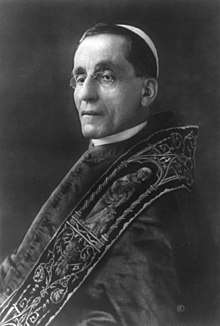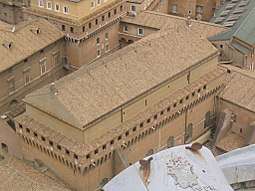1914 papal conclave
The 1914 papal conclave was held to choose a successor to Pope Pius X, who had died in the Vatican on 20 August 1914.
| Papal conclave August–September 1914 | |
|---|---|
| Dates and location | |
| 31 August – 3 September 1914 Sistine Chapel, Apostolic Palace, Rome | |
| Key officials | |
| Dean | Serafino Vannutelli |
| Sub-dean | Francesco di Paola Cassetta |
| Camerlengo | Francesco Salesio Della Volpe |
| Protodeacon | Francesco Salesio Della Volpe |
| Election | |
| Ballots | 10 |
| Elected pope | |
| Giacomo della Chiesa Name taken: Benedict XV | |
 | |
Political context

Europe was already at war and the new pope would face the question of maintaining neutrality or assume moral leadership as Catholic Belgium and France were attacked by Protestant Germany, which was supported by Catholic Austria while the Protestant United Kingdom of Great Britain and Ireland (including Catholic Ireland) and Russian Orthodox Russia sided with France.
The conclave brought together cardinals from the combatant nations, including Károly Hornig from Austria-Hungary, Louis Luçon from France, Felix von Hartmann from Germany and two from the United Kingdom of Great Britain and Ireland, Francis Bourne and Michael Logue. The Belgian Désiré-Joseph Mercier needed the permission of the Emperor of Germany to leave his country.[1]
Despite the fact that some cardinals had found it impossible to reach Rome in time to participate in earlier conclaves, the revised set of rules promulgated by Pius X in the Vacante Sede Apostolica on 25 December 1904 required the cardinals to wait only ten days after the death of the pope before starting a conclave.[1] The two cardinals who traveled from the United States, James Gibbons of Baltimore and William O'Connell of Boston, did not reach Rome in time to participate in the conclave,[2] nor did Louis-Nazaire Bégin of Quebec.[3] Five more were too ill or too frail.[3]
Veto abolished
Pope Pius X had issued two apostolic constitutions on the subject of papal conclaves. The first, Commissum Nobis of 20 January 1904, eliminated any secular monarch's claim to a veto over a candidate for election. It established that anyone who attempted to introduce a veto in the conclave would incur automatic excommunication. For the first time in centuries the cardinals alone would make the choice.
Balloting
The conclave itself assembled in the Sistine Chapel on 31 August. From the beginning of the conclave, it was clear that there were only three possible winners. Domenico Serafini, a Benedictine and assessor at the Holy Office, won the support of the Curia to continue Pius X's anti-modernist campaign as his chief priority. However, many other cardinals, such as Carlo Ferrari and Desiré Merciér, believed that a Pope with a different focus was needed and supported the Archbishop of Pisa Pietro Maffi, considered very liberal but tainted by being close to the House of Savoy. Giacomo della Chiesa, Archbishop of Bologna, stood intermediate between Maffi and Serafini, but in the early ballots he was equal with Maffi and seemed to be winning some support from conservative factions. Della Chiesa drew ahead by five votes after the fourth ballot, and once it became clear Maffi had no hope whatsoever of gaining two-thirds of the votes, Serafini became Della Chiesa's opponent. By 3 September 1914, on the tenth ballot, all of Maffi's supporters had switched to Della Chiesa, who was elected pope. He took the name Benedict XV.
Reportedly Della Chiesa had been elected by one vote. According to the rules in force at the time, the ballot papers had a numbering on the reverse side, so that, if the election was decided by only one vote, it could be checked whether or not the elected person had voted for himself, in which case the election would be void. According to that account, Cardinal Rafael Merry del Val, who had been Pius X's Secretary of State, insisted that the ballots be checked to ensure that Della Chiesa had not voted for himself – he had not. When the cardinals offered their homage to the new pope, Benedict allegedly said to Merry del Val, "The stone that the builders rejected has become the cornerstone." To which the unabashed Merry del Val replied with the next verse of Psalm 118: "This is the Lord’s doing; it is marvelous in our eyes."[4]
Cardinal Merry del Val wasn't reappointed as Secretary of State by the new Pope, but was named Secretary of the Supreme Sacred Congregation of the Holy Office (then the head of that Dicastery, because the Popes themselves retained the office of Prefect of the Holy Office, leaving its daily administration to the secretary).
| LENGTH OF CONCLAVE | 4 days |
|---|---|
| NUMBER OF BALLOTS | 10 |
| ELECTORS | 65 |
| Absent | 8 |
| Present | 57 |
| Africa | 0 |
| South America | 1 |
| North America | 1 |
| Asia | 0 |
| Europe | 55 |
| Oceania | 0 |
| Italians | 33 |
| DECEASED POPE | PIUS X (1903–1914) |
| NEW POPE | BENEDICT XV (1914–1922) |
References
- Walsh, Michael J. (2003). The Conclave: A Sometimes Secret and Occasionally Bloody History of Papal Elections. Rowman & Littlefield. p. 147. Retrieved 17 May 2018.
- Chadwick, Owen (1998). A History of the Popes, 1830-1914. Oxford University Press. p. 336. Retrieved 13 November 2017.
- Burkle-Young, Francis A. (2000). Papal Elections in the Age of Transition, 1878-1922. Lexington Books. p. 103. Retrieved 15 November 2017.
- Weigel, George (21 April 2005). "Conclaves: Surprises abound in the Sistine Chapel". The Madison Catholic Herald Online. Retrieved 13 February 2014.